
Ozothamnus ferrugineus, commonly known as tree everlasting, is a member of the genus Ozothamnus, of the Asteraceae family – one of the largest families of flowering plants in Australia. Native to the Australian states of New South Wales, Victoria, South Australia, and Tasmania, it forms an erect shrub or small tree between 2 and 3 metres in height.

Olearia ramulosa, commonly known as twiggy daisy-bush, is a species of flowering plant in the family Asteraceae and is endemic to south-eastern Australia. It is a shrub with narrowly elliptic, linear or narrowly egg-shaped leaves, and pale blue, mauve or white and yellow, daisy-like inflorescences.
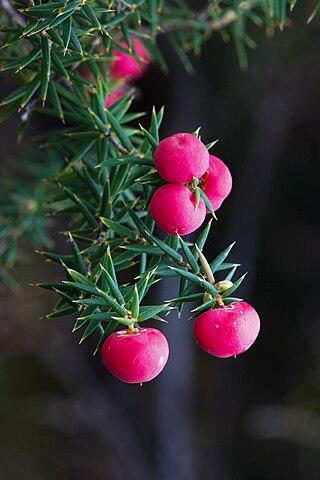
Leptecophylla is a genus of flowering plants in the Epacridaceae family, a subfamily of Ericaceae. The genus is native to southeastern Australia, New Zealand, Papua New Guinea and the Pacific Islands. Some species in this genus were formerly classified within the genera Cyathodes, Lissanthe, Styphelia and Trochocarpa.

Leptecophylla juniperina is an Australasian species of flowering plant in the family Ericaceae.
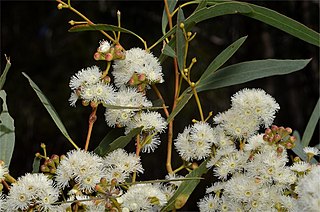
Eucalyptus amygdalina, commonly known as black peppermint, is a species of flowering plant that is endemic to Tasmania. It is a small to medium-sized tree with rough bark on park of the trunk, smooth grey to brown bark above, lance-shaped to linear adult leaves, oval to club-shaped flower buds, white flowers and cup-shaped to hemispherical fruit.

Pultenaea juniperina, commonly known as prickly bush-pea or prickly beauty is a species of flowering plant in the family Fabaceae and is endemic to south-eastern Australia. It is an erect, spiky shrub with hairy stems, linear to narrow elliptic leaves with stipules at the base, and yellow-orange and red flowers.

Styphelia sieberi, commonly known as prickly beard-heath, is a species of flowering plant in the heath family Ericaceae and is endemic to south-eastern continental Australia. It is an erect, densely-branched shrub with oblong to more or less egg-shaped leaves with the narrower end towards the base, and white, tube-shaped flowers arranged singly in upper leaf axils.

Persoonia juniperina, commonly known as prickly geebung, is a species of flowering plant in the family Proteaceae and is endemic to south-eastern Australia. It is a small erect to low-lying shrub with smooth bark, hairy new branches, linear leaves, yellow flowers borne singly or in groups of up to forty in leaf axils, and yellowish green to purplish fruit.
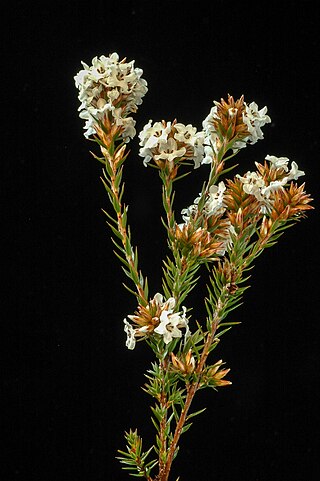
Epacris lanuginosa, commonly known as woolly-style heath, is a species of flowering plant in the family Ericaceae and is endemic to south-eastern Australia. It is a slender, erect shrub with hairy branchlets, linear to lance-shaped leaves, and tube-shaped, white flowers crowded along the ends of the branches.

Billardiera fusiformis, commonly known as Australian bluebell, is a species of flowering plant in the family Pittosporaceae and is endemic to the south-west of Western Australia. It is a sturdy, shrubby climber that has linear to narrowly elliptic leaves and blue, white or pink, nodding flowers arranged singly or in groups of up to four.
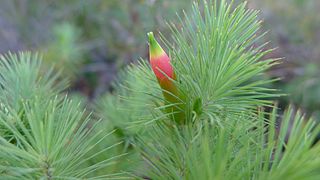
Stenanthera pinifolia, commonly known as pine heath, is a species flowering plant in the family Ericaceae. It is a of shrub that is endemic to south-eastern Australia. It has narrow, linear leaves, yellow or red tubular flowers and a small edible berry.

Goodenia elongata, commonly known as lanky goodenia, is a species of flowering plant in the family Goodeniaceae and is endemic to south-eastern Australia. It is an erect or ascending herb with lance-shaped stem leaves, and yellow flowers arranged singly or in racemes.
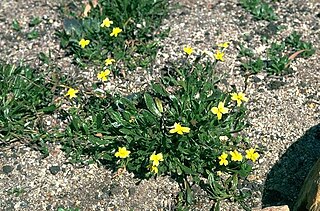
Goodenia geniculata, commonly known as bent goodenia or native primrose, is a species of flowering plant in the family Goodeniaceae and is endemic to south-eastern Australia. It is a low-lying to ascending herb with linear to lance-shaped, often toothed leaves at the base of the plant and racemes of yellow flowers with hairy backs.

Hibbertia acicularis, commonly known as prickly guinea-flower, is a species of flowering plant in the family Dilleniaceae and is endemic to eastern Australia. It is an erect or prostrate shrub with linear to lance-shaped leaves and yellow flowers arranged singly in leaf axils with the six to eight stamens joined at the base, in a single cluster.

Leptecophylla parvifolia, commonly known as the mountain pinkberry, is a small to medium sized species of shrub in the family Ericaceae that is endemic to the highlands of Tasmania. This species was first collected and documented in 1804 by Robert Brown and was formerly included in the Cythodes genus. It was then as noted as subspecies of Leptecophylla junipernia but in 2018, was classified as its own species
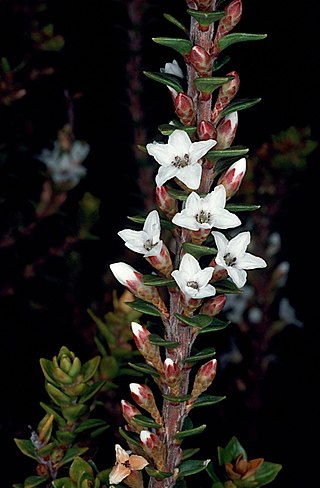
Epacris myrtifolia is a species of flowering plant in the heath family Ericaceae and is endemic to Tasmania. It is an erect shrub that typically grows to a height of 15–50 cm (5.9–19.7 in). Its leaves are thick, crowded, egg-shaped with a small, blunt point on the tip, and 4.2–8.5 mm (0.17–0.33 in) long. The flowers are arranged singly in a few upper leaf axils with many leathery bracts at the base. The sepals are leathery, about 4.2 mm (0.17 in) long, the petal tube slightly shorter than the sepals with lobes about the same length, the anthers protruding slightly from the petal tube.
Pimelea cinerea is a species of flowering plant in the family Thymelaeaceae and is endemic to Tasmania. It is a slender shrub with more or less elliptic leaves, and heads of white flowers surrounded by leaves.

Leucopogon virgatus, commonly known as common beard-heath, is a species of flowering plant in the heath family Ericaceae and is endemic to south-eastern Australia. It is an erect to low-lying shrub with linear to narrowly lance-shaped or egg-shaped leaves, and erect clusters of three to seven white, tube-shaped flowers on the ends of branches and in upper leaf axils.
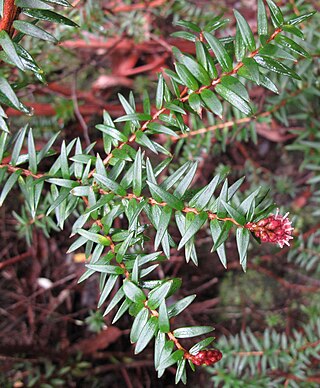
Trochocarpa disticha is a flowering plant species of the family Ericaceae and is endemic to Tasmania. It is a tall shrub with slender branches, its leaves egg-shaped to narrowly lance-shaped and arranged in two opposite rows (distichous), reddish flowers in curved spikes with bell-shaped petal tubes, and deep to pale purple drupes.

Acrotriche cordata, commonly known as coast ground-berry, is a species of flowering plant in the family Ericaceae and is endemic to southern Australia. It is an erect or spreading shrub, with linear, oblong or egg-shaped leaves, and spikes of tube-shaped, pale green, flowers, and succulent pale green drupes.






















